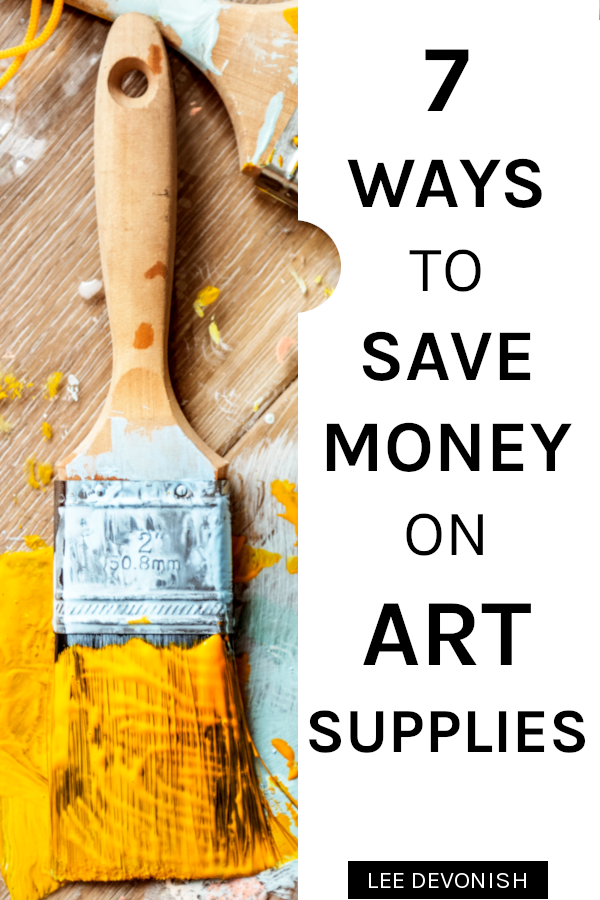7 ways to save money on art supplies - whether you want to sell art or just save money on art materials here are tips to help you spend less.
This post contains affiliate links, marked by *
First of all, you might want to check out my new post on the best UK art and craft store sales here, because I’ve started to compile lots of deals, sales and discounts there to help you save. Besides that, here are some more ways to save money on art supplies.
Buy art supplies second-hand
Over the years, I’ve furnished my entire life via eBay.
That includes an entire ceramics studio, back when I believed I was meant to be a serious studio ceramicist.
Actually, that never worked out for me, and I ended up having to sell the entire contents of my ceramics studio on eBay* for £100. Yes, £100.
It was a distress sale and I just needed someone to take it all away, as I couldn’t keep it or take it with me when I moved.
I needed it gone, and another artist got an amazing deal.
Artists, art schools, colleges and universities often offload unneeded machinery on eBay*, so set up a custom search in your area and get alerts if anything comes up.
Besides eBay, there’s Preloved, Gumtree, Freecycle, Facebook Marketplace, and of course, the good old charity shop.

Make it yourself
As the old saying goes, necessity is the mother of invention. In some cases, you can save money on art supplies by making your own art supplies!
Creating your own paints or ceramic glazes, for example, is a very specialised skill, but you can often start small and potentially develop that valuable specialism.
Even if you only want to experiment on a small scale, you’ll probably find that by taking the time to learn how raw materials work, you’ll enrich your artwork and feel more connected to it. It’s a bit like seeing where your food comes from instead of thinking it magically appears in plastic wrap in the supermarket.
YouTube is great for every kind of tutorial, and there are videos about making your own oil paints, dyes and more. When you learn how things are made and why, you’ll be able to substitute ingredients or come up with something entirely unique to you – how good does that sound?
DIY framing
You’ll be doing yourself a favour if you can improve your framing skills, as professional framing can form a huge part of your expenses if you want to exhibit. It doesn’t make sense to spend a lot of time working out how to save money on art supplies only to spend it all on expensive framing, does it?
Still, there’s a limit to what we can reasonably learn or do well, so if you can’t present your work to a professional standard on your own, consider whether you can set aside some time to practise until you improve, or factor in the inevitable need for presentation in the way you make the work in the first place – i.e. using deep canvases that won’t require framing.
There are some pieces of equipment that you can buy cheaply, like a tab driver*, to allow you to professionally finish your frame backing. This way, even if you re-use frames, they’ll look as though they were done for you by a pro!

Adapt your practice and medium to your circumstances
Back in my first year at MassArt, my ceramics tutor Ben Ryterband gave us a great bit of advice for life after art school that I didn’t exactly follow: if or when you find yourself in a position where you don’t have access to a wheel or a kiln, don’t stop – just keep making – whatever it is, drawing, painting, whatever.
Simply keep making. It all counts.
Over the years I have ended up responding to the winding road of my life by turning my hands to a crazy variety of things. Because of my circumstances I haven’t continuously pursued fine art, but I’ve always been creating something. Out of that, I’ve learned that there is an honesty to work derived from your personal circumstances, and your financial circumstances are no less important a source.
The process of making work from found objects can add new layers of life to your work, producing a rich, multi-faceted outcome.
Shop smarter
Sometimes you just need to buy things new. When you do, make the most of your money by using these two tips:
1 – Get cashback wherever you can
Sign up to cashback websites such as TopCashback* and Quidco* to get money back on your purchases without costing you a penny.
Visit the cashback website, search for the store you want to buy from and click through from there. Shop as you normally would, and you’ll get a percentage of your purchase price refunded to you.
Find out more about how cashback works here.
2 – Use gift cards
There are online marketplaces that let individuals sell on unwanted gift cards, and you can often find discounted gift cards for specialist art stores, as well as stores that sell a general range of useful products.
Try Cardyard for buying gift cards.
These two tips will save you a lot of money in your everyday life, not just on art materials!
Beware of the heritage premium
I totally made that phrase up, but it sums up what I mean.
There’s a powerful psychological pull towards fitting in that makes many of us want to buy “traditionally” branded products. (Read my rant about the trouble with tradition.)
Manufacturers know how to manipulate the famous artist brand – just think of the amount of things named after artists that those artists themselves would never have heard of.
Because of this, I have a great distrust of any art materials that heavily reference the old masters… I’d rather unearth real quality than jump at something that has borrowed a famous name. There is a lot to be said for buying good quality materials, but sticking to safe bets can stifle creativity.
The same goes for celebrity branded or endorsed materials: don’t get conned into paying for a name.

Plan your project and create a budget
As an art technician, I’ve seen ambitious projects fall apart because of the unexpected cost of the materials required. It’s not very exciting, but you will definitely need to price up your project before you start to see if it’s even feasible, and how you can possibly make it cheaper.
Boring, I know, but essential!
When you plan, you can figure out if you can:
- substitute costly materials for inexpensive ones, at least where they won’t be visible
- fill volume to avoid using too much material where it won’t be visible or needed
- afford storage, transportation and dismantling
- raise funding for the costs involved
This is a good thing to do from the start, as it also helps you to price your work for sale.
Collaborate and share with other artists
There are some resources that are wasted when there aren’t enough people involved to put them to good use. I’m talking about things like kiln sharing, staging exhibitions and studio subletting, for example.
Buying art materials in bulk and splitting the costs evenly can result in lower spending for everyone, but even when it comes to sharing knowledge, finding out what someone else knows could mean you avoid costly mistakes or find out something you never knew before that suddenly makes life easier (and cheaper).
If you’re not part of an art collective you might not know where to start, but there are lots of groups online that you can join.
Why not join my Facebook group – Make Art, Save (And Make!) Money – we’d love more suggestions, and the more of us there are, the more we can help each other save money on art materials!
Well, we all know the feeling of spending too much on the things we love, such as art. As much as we make art for love, we have to be practical at some point and factor in the cost of our materials; after all, this will affect the price we charge when we go on to sell our work, or at least, have an effect on the amount of work we are able to produce.
So there you go – I hope these ways to save money on art supplies have helped you as much as they’ve helped me.



Leave a Response